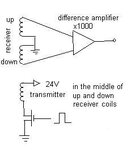anotherbrick
Full Member level 4
- Joined
- Jan 10, 2009
- Messages
- 217
- Helped
- 1
- Reputation
- 2
- Reaction score
- 1
- Trophy points
- 1,298
- Location
- Istanbul , Turkey
- Activity points
- 3,142
hello dear forum,
I was asked to build a metal dedector for
catching every type of metal particles
in the output of plastic shredding machine for recycling of used plastics
I need to dedect every kind of metal not just iron
I searched google and come upon 3 types of dedectors
Beat Frequency Operation, Pulse Induction, and Induction Balance
which type do you suggest me for my purpose ?
thank you
I was asked to build a metal dedector for
catching every type of metal particles
in the output of plastic shredding machine for recycling of used plastics
I need to dedect every kind of metal not just iron
I searched google and come upon 3 types of dedectors
Beat Frequency Operation, Pulse Induction, and Induction Balance
which type do you suggest me for my purpose ?
thank you
